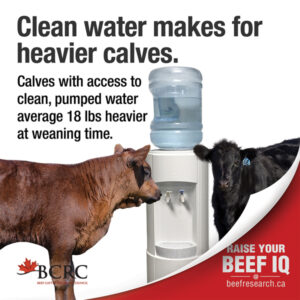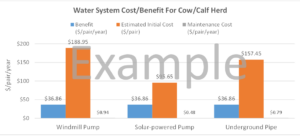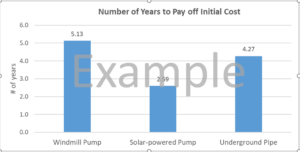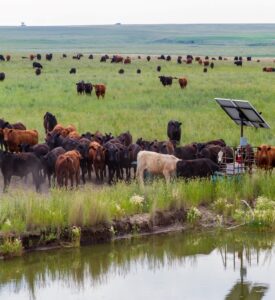What Does It Cost (and Save) to Set Up a Livestock Water System?
Try BCRC’s Updated Water Systems Calculator
What if cattle producers could adopt a single practice that would improve livestock production, help conserve water and improve the environment? Developing an off-site or remote water system may achieve that.
Water is an essential nutrient for cattle, accounting for between 50 and 80 per cent of an animal’s live weight. For optimum health, cattle need a consistent source and adequate supply of water each day. Access to fresh, clean water increases animals’ water intake, which in turn, increases their feed intake and improves animal performance. On top of potential production benefits, producers often report improved animal health from reduced bacterial consumption. In addition, there are less instances of mastitis and foot rot when animals are not regularly standing in water.
Remote or off-site water systems are set-ups that pump water from the source (such as a dugout, pond or dam) into a trough. This reduces the number of cattle directly accessing water. And, if the source is fenced, it will remove cattle from the water source entirely. Water can be pumped using solar or wind power, gravity or even animal power.
To provide cattle with a safe, reliable supply of good quality water, many producers are using remote water systems. According to the Farm Management Survey 2017, 54 per cent of beef cattle operations where livestock had limited or no access to surface water used remote or offsite water systems.
Remote Pasture Water System Benefits:
- water source protection, including extending stock water during dry conditions
- improved herd health
- potential increase in livestock gains
- better pasture utilization
- riparian habitat protection, which reduces the environmental impact of the livestock industry
- remote winter water systems encourage livestock distribution away from the farmyard, which reduces manure buildup in calving areas and associated animal health problems as well as manure hauling costs
Adapted from Remote Pasture Water Systems for Livestock (Alberta Agriculture)
When designing a livestock water system, economic analysis and projections are helpful. The Beef Cattle Research Council’s Water Systems Calculator is a useful tool.
The calculator has a cow/calf and yearling grasser version that compares various water systems.
| Cow/Calf Version | Yearling Grasser Version |
|---|---|
| Windmill pump | Windmill pump |
| Solar-powered pump | Solar-powered pump |
| Underground pipeline | Underground pipeline |
| Aerated windmill pump | |
| Aerated solar-powered pump |
use the BCRC’s Water Systems Calculator to:
- compare costs of different livestock water systems, including initial set-up and maintenance costs
- estimate potential economic benefits from additional weight gain compared to direct access to dugout water
- calculate how much time it will take to pay off the system
The economics of water systems depend on initial costs, capacity, herd size and cattle prices. The updated calculator allows greater flexibility to reflect different situations and allows producers to:
- use their own herd size and adjust cattle daily water consumption to calculate daily water requirement
- change the infrastructure setting (e.g., number of wells, troughs and stock tanks)
- choose to use the default prices or enter their own prices for different parts of the water system
- use their projected sale price for the cattle being watered to estimate the potential economic benefit from additional weight gain
Results are shown in interactive charts which help producers visualize the potential economic outcomes. To see examples of cost-benefit analysis based on this water system calculator, check out the Economics of Water Systems factsheet by Canfax Research Services.
While the calculator focuses on the economics of three water systems, there are numerous water system options (e.g., gravity flow system, livestock powered nose pumps) available. Add-ons such as motion detectors, drones and cameras can assist producers in overall water system operation and monitoring. Given the variety in cost of different types of equipment, producers are encouraged to explore their options with considerations of the farm’s capital and labour availability.
In different regions, there are also financial assistance programs available for developing a livestock water system. Some examples are:
- Canadian Agricultural Partnership
- Farm and Ranch Water Infrastructure Program
- Ag Action Manitoba Program
To select a water system that best fits the operation’s economic and environmental goals, producers need to give careful thought to matching herd water requirements with grazing management and site conditions. Experience and insights from other producers, especially those with similar production systems, management practices or site conditions, can provide valuable information for new adopters.
Producers’ Tips for Livestock Water systems:
- If watering pairs, ensure the trough is low enough for calves to access.
- Use of insulated tanks helps to keep water from freezing during cold weather.
- When using a solar pump system, arrange the angle of your solar panels to capture the most sunlight possible. This needs to be adjusted according to winter or summer use.
- Place your trough in a location where the topography naturally slopes away from the dugout. This prevents manure from draining back into the source.
- When pumping water from a dugout or dam, cattle should have emergency access to the water source if the system fails.
“When given a choice, cattle will drink from a trough eight times out of ten, even if they have access to surface water.”
– Cows and Fish
With a well-designed water system, producers can benefit from improved cattle productivity, sustain their valuable water resources and, at the same time, do their part to protect water and contribute to a more environmentally friendly cattle industry.
Additional Resources
- Water Systems for Beef Cattle (BCRC webpage)
- What’s In Your (Stock) Water? (BCRC article)
- Three Producers Share Ideas That Improve Efficiency (BCRC article)
- Test Stock Water & Reduce Worry (BCRC webpage)
Sharing or reprinting BCRC posts is welcome and encouraged. Please credit the Beef Cattle Research Council, provide the website address, www.BeefResearch.ca, and let us know you have chosen to share the article by emailing us at [email protected].
Your questions, comments and suggestions are welcome. Contact us directly or spark a public discussion by posting your thoughts below.




